
Special Report




Executive Summary
BDO Seidman, LLP (BDO) was engaged by the Wisconsin Health Care Association (WHCA) and the Wisconsin Association of Homes and Services for the Aging (WAHSA) to conduct a study on the financial condition of nursing home facilities in Wisconsin. Specifically, we were asked to determine whether facilities are experiencing serious financial difficulties, identify the major contributing factors, and estimate the fiscal impact of establishing a more reasonable Medicaid reimbursement system. BDO has worked extensively in the redesign of Medicaid payment systems throughout the country and a synopsis of their experience and expertise is included as Appendix 1.
Wisconsin’s nursing facilities are in serious financial distress. We identified several factors leading to their poor financial condition, including federal Medicare payment reductions, declining nursing home occupancy levels and acute labor shortages. However, our analysis indicates, without question, that the inadequacies of the Wisconsin Medicaid payment system have had the greatest impact on the deterioration of the financial and operational condition of Wisconsin’s nursing facilities.
Key Findings
Our key findings, summarized here, and more fully detailed elsewhere in this report, are as follows:
Introduction and Purpose
BDO Seidman, LLP (BDO) was engaged by the Wisconsin Health Care Association (WHCA) and the Wisconsin Association of Homes and Services for the Aging (WAHSA) to conduct a study on the financial condition of nursing home facilities in Wisconsin. Specifically, we were asked to determine whether facilities are experiencing serious financial difficulties, identify the major contributing factors, and estimate the fiscal impact of establishing a more reasonable Medicaid reimbursement system. BDO has worked extensively in the redesign of Medicaid payment systems throughout the country and a synopsis of their experience and expertise is included as Appendix 1.
Wisconsin’s nursing facilities are in serious financial distress. We identified several factors leading to their poor financial condition, including federal Medicare payment reductions, declining nursing home occupancy levels and acute labor shortages. However, our analysis indicates, without question, that the inadequacies of the Wisconsin Medicaid payment system have had the greatest impact on the deterioration of the financial and operational condition of Wisconsin’s nursing facilities.
Adequacy of Medicaid Payment in Wisconsin
Medicaid is the primary payor source for nursing home care. In Wisconsin, almost 70% of nursing home residents have Medicaid as their payor source. Only 23% of the residents are private pay, with Medicare and managed care making up the difference.1 As such, adequate Medicaid payment is the most important element in the fiscal equation.
We examined the adequacy of Medicaid payment by identifying the number and percentage of facilities being fully reimbursed their Medicaid allowable costs and analyzed the magnitude of the losses being incurred by facilities on Medicaid patients. We also compared Wisconsin to other states in relation to where they set their reimbursement ceilings or maximums. The higher the ceilings, the greater the number of facilities being paid all their Medicaid allowable costs in that cost center. Finally, we estimated the cost to develop a Medicaid payment system comparable to what other states have recently done to ensure fair and adequate payment for quality patient care.
Existing Medicaid Payment
In analyzing the adequacy of Medicaid payment, we utilized cost and rate data obtained from the Department of Health and Family Services, Division of Health Care Financing for the rate year of July 1, 1999 to June 30, 2000. Information was obtained in electronic format for 328 facilities whose rates had been set by the time we began this engagement. These 328 facilities represent approximately 75% of the nursing homes and Medicaid patient days statewide. The cost data, from 1998 “desk or field audited” cost reports, was inflated forward to the rate year using the Skilled Nursing Facility Market Basket Index, a nursing home inflation estimator. The inflation estimate was conservative, in that historically, nursing home inflation in Wisconsin exceeds this nursing home index by one to two percent annually. In other words, the allowable Medicaid expenses that were compared to Medicaid rates were likely understated.
The analysis revealed that only 17% of facilities in Wisconsin (57 out of 328) were fully reimbursed their allowable Medicaid costs for the rate year of July 1, 1999 to June 30, 2000. The average loss for 83% of Wisconsin facilities was almost $11 per patient day (ppd.). For a 100 bed facility, with a 70% Medicaid census, this represents an annual loss of approximately $250,000. Total Medicaid losses for the 271 facilities losing money on Medicaid exceeded $78 million. Extrapolating this loss to the universe of all Wisconsin nursing homes resulted in Medicaid losses for all Wisconsin facilities exceeding $100 million in 1999-2000. A breakdown, by type of ownership, is as follows:
|
Rate Year Ending 6/30/00 |
For Profit |
Non-Profit |
Governmental |
Total |
|
|
40 |
10 |
7 |
57 |
|
|
|
|
|
|
|
Percent of total |
25.8% |
8.5% |
12.7% |
17.4% |
|
|
|
|
|
|
|
Number of homes losing |
115 |
108 |
48 |
271 |
|
|
|
|
|
|
|
Percent of total |
74.2% |
91.5% |
87.3% |
82.6% |
|
|
|
|
|
|
|
|
$7.23 |
$10.56 |
$15.88 |
$10.90 |
Medicaid Reimbursement - Wisconsin vs. Other States
Medicaid rate comparisons are often made among states, but higher rates are not necessarily an indication of a better or more equitable payment system. What is relevant is whether Medicaid reimbursement adequately covers the Medicaid costs incurred by nursing homes in that state.
For example, Medicaid rates in Mississippi are lower than in Wisconsin. The primary reason is that salaries and benefits paid to Mississippi nursing home employees are much less than in Wisconsin. However, more facilities in Mississippi are fully reimbursed their Medicaid costs than in Wisconsin because Mississippi sets ceilings at a higher percentage above the median cost of nursing home facilities. Thus, Mississippi’s Medicaid payment system is more equitable in reimbursing Medicaid costs being incurred by facilities in their state.
There are no published comparisons among states of the percentage of homes being reimbursed their total Medicaid costs. Historically, many state agencies and provider associations did prepare such cost coverage analysis to insure compliance with the now repealed “Boren Amendment,” a federal law which required that Medicaid rates be adequate to meet the costs that must be incurred by economically and efficiently-operated facilities. The standard or benchmark that evolved from that legislation was that adequate payment meant that at least 50% of facilities were fully reimbursed their Medicaid costs. Wisconsin, at 17.4%, fell woefully short of that mark in fiscal year 2000, and will do even worse in fiscal year 2001.
Our experience, based upon having prepared cost coverage analyses in over 20% of the states, and having worked in the development or application of Medicaid payment systems in numerous others, is that Wisconsin ranks near the bottom in adequately reimbursing the Medicaid costs of nursing homes. The reasons are twofold:
|
|
|||
|
COST CENTER |
1990 |
2000 |
ESTIMATED REDUCTION IN CEILING AMOUNT P.P.D. |
|
DIRECT CARE |
13% |
2.3% |
$6.00 |
|
SUPPORT SERVICES |
9.5% |
2% |
|
|
AMINISTRATION |
12% |
2% |
$1.00 |
|
UTILITIES |
15% |
2% |
$.25 |
Additional Funding Needs
We estimated the additional Medicaid funding required to increase ceilings to levels comparable with other states. We increased ceilings in direct care, support services, and administration to 15%, 10%, and 10%, above the median, respectively. Doing so, would require increased annual Medicaid funding of approximately $30 million ($14.3 GPR) for fiscal year 2000. However, doing so still results in only 26% of nursing home facilities receiving all of their allowable Medicaid costs, which leads to the second major problem with the system: that being too many cost centers.
The current Medicaid system has seven different cost centers, of which five have separate ceilings. The other two (property taxes and over-the-counter drugs) are reimbursed based upon actual costs incurred. Historically, many state agencies set multiple ceilings hoping to insure efficiency in each cost center. However, doing so has proven to be administratively burdensome, reduces facilities’ flexibility in managing overall costs, and ignores the reality that expenditures in one cost center can impact those in another.
For example, a greater expenditure in Human Resources (an administrative cost) may lower turnover, increase productivity, and reduce costs in another cost center. Overall costs are reduced, but the provider may be penalized because of higher administrative costs. Establishing multiple cost centers, each with their own ceilings, is simply designed to reduce the number of facilities being reimbursed their Medicaid costs. It also often leads to gaming as facilities try to cost shift due to exceeding ceilings in one cost center while being below in another. States that have redesigned their payment systems in the past few years have reduced the number of cost centers to three or four; typically direct care, support services, and property.
We modeled the impact of modifying Wisconsin’s payment system for fiscal year 2000 to one with three cost centers (direct care, support, and property) plus a pass-through of property taxes. Ceilings for direct care and support services were set at 15% and 10% above the median, respectively. The property payment was adjusted to be comparable to other states that provide adequate capital payment to cover both reasonable mortgage debt and costs associated with remodeling and renovation. This was accomplished by increasing the property payment ceiling by 2% from its current level of 7.5% of facility value to 9.5%. At one time, the ceiling was as high as 10.75% of facility value. Revising the payment system in this fashion would require increased annual Medicaid funding of approximately $57 million ($27/GPR) for 1999-2000. This approach would result in approximately 60% of facilities being fully reimbursed their Medicaid costs, with 40% still losing money on Medicaid.
Such a proposed system is not “generous” by any standard. It is equitable, given existing nursing home expenditure patterns and payment parameters in other states. However, it does not represent adequate funding for other initiatives such as rectifying staffing shortages, meeting nurse aide staffing levels for optimum care as defined in the Health Care Financing Administration’s (HCFA) recent report to Congress on minimum nurse staffing, providing more competitive wage and benefit packages, or moving to a new classification and payment system similar to the Medicare PPS concept.
Other Factors Contributing
to Facilities' Financial Difficulties
Medicare PPS
The financial condition of nursing home facilities has been adversely impacted by the Federal Medicare Prospective Payment System which reduced Medicare payments to nursing homes by 10%, or $1.3 billion, from 1998 to 1999. For major nursing home companies, Medicare per diem payments fell by 20% from the second quarter of 1998 to the fourth quarter of 1999. Since July 1998, more than 1,800 skilled nursing facilities across the country have declared bankruptcy including five of the seven largest nursing home companies.4 Over the past two and one-half years, the equity market for major nursing home companies fell by nearly $12 billion with the average share price falling by 77%.4 In Wisconsin, 43 facilities are in bankruptcy, representing over 10% of the facilities in the state. This percentage is over double that of surrounding states in the Midwest where the percentage of facilities in bankruptcy is 4.8%.5
Congressional Budget Office projections now show that Medicare nursing home spending between 1998 and 2004 will be $15.8 billion less than projected, which is twice the payment reduction intended by Congress for nursing home facilities.6 Based upon these projections, the reduction in Medicare payments to Wisconsin nursing homes is estimated at $772 million.7
The severe Medicare cuts have serious Medicaid rate implications. Historically, Medicaid programs, like that in Wisconsin, paid only 90-95% of facilities’ Medicaid costs, knowing that the difference could be subsidized by private pay patients and Medicare margins. With Medicare margins substantially reduced, or in many cases, totally eliminated, Medicaid programs must now pay a higher percentage of Medicaid costs for facilities to be financially and operationally viable.
Occupancy
Occupancy in nursing homes has declined significantly. Based upon 1998 data, average occupancy in Wisconsin nursing homes is down to 87%; a decline of almost five percent from 1993.8 Service delivery options such as assisted living and home and community-based programs have greatly expanded, resulting in lower nursing home census.
That census, however, is a sicker, more frail population requiring more costly services. In Wisconsin, the number of nursing home residents in need of skilled services or intensive skilled nursing care at time of admission has increased from 79.4% in 1988 to 97% in 1998. In addition, while average skilled nursing home census in Wisconsin has declined by some 3,300 residents since 1990, average admissions in that same time period have increased 93% from 26,451 to 51,005.9 As a result, lengths of stay are much shorter, indicating treatment of patients with more complex medical and rehabilitative problems and an elderly population entering nursing homes at much later stages in their lives. In addition, many facilities have experienced a significant increase in the number of residents with significant behavioral symptoms and problems requiring additional staff and treatment resources.10
The combination of greater vacancy rates and a more costly nursing home patient has increased annual per diem costs in nursing homes greater than the general level of inflation. Unfortunately, Medicaid budgetary increases over the years have not kept pace, forcing reductions in Medicaid payment ceilings and increased Medicaid losses for most facilities.
Labor Shortage
Unemployment rates are at all time lows, making it extremely difficult to recruit and retain employees in an industry that struggles to develop a positive image, and where the workload is extremely demanding and difficult. A recent study by the University of Wisconsin-Milwaukee places the position of certified nursing assistant at the top of the list of most difficult positions to fill.
As such, nursing homes have had to increase salaries and benefits significantly beyond normal price inflation simply to remain competitive. Even after doing so, most facilities still have a significant number of unfilled positions. The May 1999 Report of the Workforce Development Group indicates that 14% of available positions for long term care workers statewide are vacant.
A 100 bed nursing facility, with 14% of its positions unfilled, is short approximately 70 hours per day of needed patient care services. These staffing shortages put an added burden on existing employees often leading to increased turnover (which already stands at over 100% for all long term care workers11) and forces facilities to utilize contracted temporary nursing help at a much higher cost. Staffing shortages also increase the probability of serious deficiencies. The HCFA’s recent report to Congress on “The Appropriateness of Minimum Nurse Staffing Ratios in Nursing Homes” indicates strong associations between low staffing and the likelihood of quality problems.
The recent Medicaid wage pass-through, targeted at certified nursing assistants, has helped, but it has not made a serious dent in the ability of facilities to obtain a full complement of needed staff. This is due to a number of factors including the availability of thousands of other job opportunities for prospective employees, the high stress levels and physical demands of nursing home work, a compensation package that is not competitive with other industries, and a negative public image.
The labor problem has been exacerbated by inadequate Medicaid payment. Reductions in Medicaid ceilings over the past decade have not allowed facilities to remain wage and benefit competitive with other industries or even with other nursing homes whose compensation packages are at the high-end of the compensation scales. The Medicaid payment system (with the exception of the wage pass-through funding) also does not timely reimburse cost increases that exceed the general level of inflation. A provider, under ceilings, that substantially enhances their wage and benefit package beyond normal inflation is not reimbursed that cost for at least 18 months, and then only prospectively. Most facilities do not have the cash flow to absorb such shortfalls for eighteen months.
Conclusion
Nursing home facilities are in a well-documented financial crisis. The reduction of Medicaid payment ceilings over the past decade, plus the reductions in fiscal year 2001, places the Wisconsin Medicaid payment system among the worst in the country. The system has eroded to the point where other payors can no longer compensate for the significant Medicaid shortfalls in payment. The problem has been compounded by excessive cuts in Medicare payment, higher vacancy rates, increasing patient acuity, an unparalleled shortage of labor, and greater competition for private pay residents.
The elderly, their families and advocates, and nursing home regulators demand and expect a high quality of care and improved patient outcomes. Such expectations come with a price tag. For the system to work, nursing home facilities and the state must partner together; facilities meeting quality of care expectations, and the state compensating them fairly and equitably for high quality care.
In summary, the Wisconsin nursing home Medicaid payment system needs simplification and an estimated increase in funding of nearly $80 million12 to:
Appendix 1 --
About BDO Seidman, LLP
BDO Seidman, LLP (BDO) is an accounting and consulting organization servicing clients through more than 40 offices and 50 alliance firm locations across the United States. As a member firm of BDO International, BDO leverages a global network of resources to serve clients abroad through more than 490 members firm offices in over 80 countries.
The firm maintains a number of specialized service lines, one of which is healthcare. BDO services hundreds of long-term care facilities, of all ownership types, throughout the United States, providing accounting, auditing, tax, feasibility, and specialized consulting in areas such as reimbursement, clinical operations, and corporate compliance.
The primary author of this report is Joseph M. Lubarsky, a partner and the firm’s National Director of Long Term Care Services. He personally has provided consulting services to nursing home associations in 20 states. His work includes conducting cost impact studies and studies on the adequacy of payment systems, designing and developing new Medicaid payment systems, and providing litigation support.
In the past two years, Mr. Lubarsky has served as lead consultant to associations on the redesign of Medicaid payment systems in Kentucky, Idaho, and Colorado. He is currently involved in the redesign of the Medicaid payment systems in Virginia, New Jersey, and Arkansas.
Appendix 2 --
Wisconsin Nursing Home Medicaid Payment Ceilings:
1989-2000
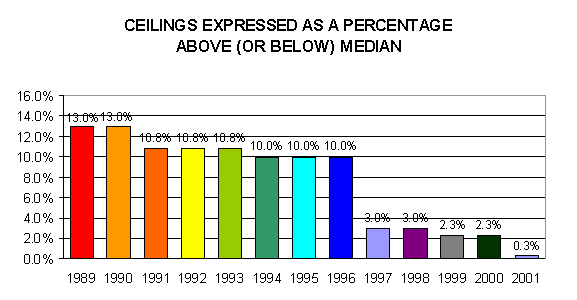
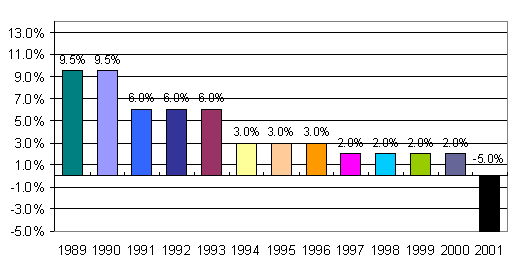
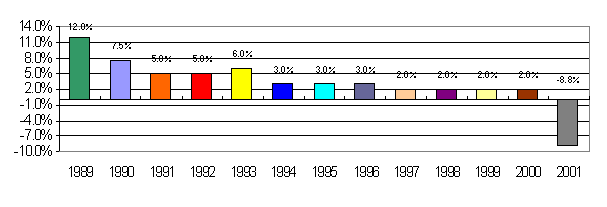
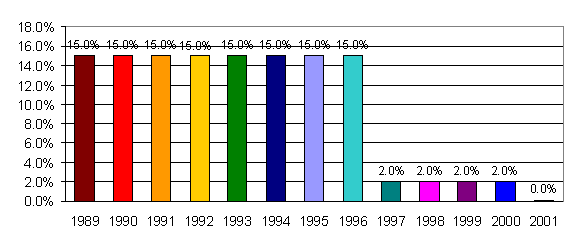
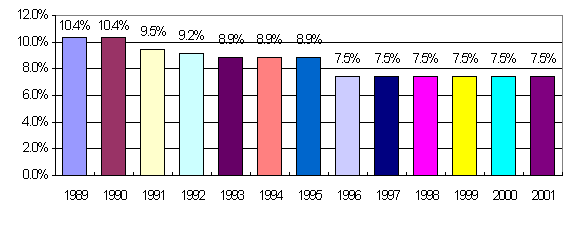
Appendix 3 --
State Comparisons of Medicaid Ceilings
State |
Direct Care (1) |
Indirect Care (1) |
Operating Cost (1) |
|
Connecticut |
135% |
115% |
100% |
|
Idaho |
128% |
123% |
|
|
Colorado |
125% |
120% |
|
|
Kansas |
125% |
130% |
115% |
|
Minnesota |
125% |
110% |
|
|
Nebraska |
125% |
115% |
115% |
|
South Dakota |
125% |
110% |
|
|
Wyoming |
125% |
105% |
|
|
Ohio |
124% |
113% |
|
|
Mississippi |
120% |
120% |
109% |
|
Missouri |
120% |
110% |
|
|
Pennsylvania |
117% |
112% |
104% |
|
Hawaii |
115% |
110% |
|
|
Vermont |
115% |
100% |
|
|
Maine |
112% |
110% |
108% |
|
Virginia |
112% |
108% |
|
|
Alabama |
110% |
110% |
105% |
|
Indiana |
110% |
100% |
|
|
New York |
110% |
108% |
|
|
Montana |
109% |
103% |
|
|
South Carolina |
105% |
105% |
105% |
|
Georgia |
90th (2) |
85th (2) |
70th (2) |
|
North Carolina |
80th (2) |
Flat Rate |
|
|
Maryland |
75th (2) |
119% |
114% |
|
Kentucky |
(3) |
(3) |
|
|
|
|
|
|
|
Wisconsin |
100% |
95% |
91.8% |


